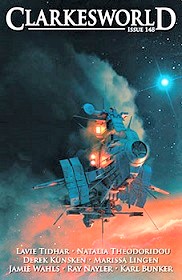 Clarkesworld #148, January 2019
Clarkesworld #148, January 2019
“Eater of Worlds” by Jamie Wahls
Reviewed by Jeffrey Steven Abrams
“Eater of Worlds” by Jamie Wahls
In this brilliant tale of Earth’s distant future, a sliver, smaller than a rose thorn, hurtles through space and shatters the moon upon impact. Slowed, the sliver drifts to Earth, its mission begun.
As Earth’s defenses encapsulate the intruder, pilot Kali awakens. She’s young, intelligent, brattish, and in charge of a mission of which she knows little. Instinctively, she ejects thousands of clones before her prison is complete. One escapes.
While speeding across Earth’s surface in search of a tower called “The Spire,” the new sliver unintentionally slices through a youth sitting in a bathtub. Wahls’s graphic description is coldly dispassionate, a reasonable reaction from Kali’s perspective, but hard to read, nonetheless.
When Kali completes her mission by finding the Spire, she learns that her sole reason for living had been to be part of a weapon-targeting team. The realization changes her in thoughtfully unpredictable ways.
Sheer originality makes “Eater of Worlds” an unforgettable story. Written in a quirky, moving, and engaging style, it’s a must read.
“One’s Burden, Again” by Natalia Theodoridou
Futuristic mythology may be oxymoronic, but it perfectly describes this tale about two astrominers caught in a tractor beam and dropped onto an uncharted planetoid. Exploring the strange world, which amazingly has a breathable atmosphere, the miners encounter Siphos, a giant pushing a bolder toward a machine destroyed by their ship. Below them, in the base of a canyon, lies the giant’s dwelling and a conveyor belt disgorging supplies and new boulders.
Engineer Ionna comprehends the futility of Siphos’ task. The boulders he pushes into the machine are torn apart, rebuilt, then redeposited at the canyon’s base. Even after being informed of his folly, the giant chooses to continue, for it’s all he knows.
Witnessing Siphos’ pointless behavior, Ionna learns that she no longer requires the holodeck meetings with her deceased father, visits which had brought no joy but to which she had become addicted.
The story contains wonderful commentary on the need to work, goal pursuit, and effects of prolonged loneliness, but missing were some badly needed details, things like who created the oxygen atmosphere and tractor beam.
“Fire in the Bone” by Ray Nayler
Sunsetting light, filtering through the hull of a hovering starship, introduces readers to this futuristic world shared by men and robots.
The main character, a ruling-class youth living on the planet in “The Estate, is a man more interested in the colors of his boutonniere than the world around him. He is, however, smitten by his robot servant, and even though he knows a robotic uprising is imminent, plunges into the affair.
The narrative shifts back in time, to when robots arrived on the colony. Treated worse than slaves, an uprising occurs, during which a butler robot named Palmer is crucified. When removed and buried with humans, he becomes the robotic Jesus. I had a hard time with this; the similarities between Christianity and Palmerism were a little too close.
The final confrontation, dominated by great battle scenes, contains enough head-twisting ideas to keep it roaring to the end.
Even though the religious overtones may seem over-the-top to some, the combination of engaging plot and vibrant settings makes “Fire in the Bone” well worth reading.
“The Ghosts of Ganymede” by Derek Kunsken
In 2112, after being exiled from Earth, refugees from Ethiopia and Eritrea land on Ganymede. Reasons for their extraction are vague at first but rolled out skillfully as the story progresses.
The storyline branches in two directions. The first examines the social dynamics between the Ethiopians and Eritreans when they’re forced to live together in close confinement.
The second plot line veers into hard sf when rows of ice pyramids are discovered near the landing site. Intricately constructed, these hollow structures appear to be alien tombs.
When a team of investigators enter the first pyramid, Giant centipede-like shapes appear randomly and then vanish. They are ghostlike, without mass or energy.
Investigator Kedija, racked by memories of the war in Ethiopia and the dead ghosts of the atrocities she witnessed, begins to sense that the phantom shapes might provide some help for her and her community. Her discovery forever changes the new settlement.
While “The Ghosts of Ganymede” is wildly original and beautifully written, the parallels between African and centipede ghosts never worked for me. Even so it’s an enjoyable read.
“Venus in Bloom” by Lavie Tidhar
This tender story is about a floating city above Venus and the funeral of Samit, the gardener, told from the perspective of R. Brother Mekem, a robot priest who was his friend. Mekem is an old robot, built on Earth, and has helped too many humans over the course of his life. A melancholy statement summarizes his thoughts, “There is so much time in the universe, and so little of it is given over to life.”
Maya, Samit’s granddaughter, is the only human who mourns his death. For her, his passing is a call to freedom, for it allows her to travel to the surface, the place where true botanical research occurs.
There’s nothing monumental or earth-shaking about “Venus in Bloom.” It’s just a warm-hearted, pleasant vignette of what ordinary life might be like on Venus.